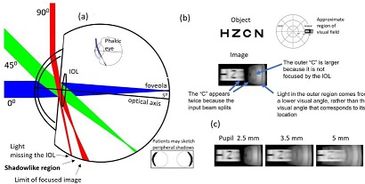Simpson Optics

Optics R&D Services
R&D relating to the design, fabrication, and testing of plastic lenses, particularly
- Intraocular Lenses
- intraocular lens (IOL) optics
- optics R&D
- IOL Optics
- Contact lenses
- Diffractive lenses
- Extended depth of focus (EDF) lenses
- Toric lenses
- Zemax calculations
- Ophthalmic optics
_____________________________________________

Original Research
"Negative Dysphotopsia" is where some patients with intraocular lenses (IOLs) see bothersome "dark shadows" in the far periphery. This is probably due to vignetting at the IOL. See Dysphotopsia, Publications, and Downloads.
The limit of vision in all directions is rarely measured, including "Far Peripheral Vision", and calculations indicate that this is reduced with an IOL. These limits should be evaluated, and compared in particular to the level of myopia, because we use the entire visual field, and other factors than defocus may affect eye growth.
The "Nodal Point" can linearly scale the retinal image to very large angles, but this is due to the highly curved cornea and retina, and the iris location, rather than to "paraxial" concepts (which are defined using flat surfaces and very small angles).
The EFL or "effective focal length" or "equivalent focal length" are all the same thing for a lens in air, but for the eye the nodal point is at f'/n'.
[Papers in preparation from "Visual and Physiological Optics" Conference, Wroclaw, Poland, August 28-30 2024:
Double Images in the Far Periphery with Intraocular Lenses
Reduction of both Axial Length and Myopia by an Orbital Tumor] intraocular lens (IOL) optics optics R&D

About Us
About Us
Michael J. Simpson, Ph.D.
Dr Simpson worked in industry for over 25 years in the Research and Development of Intraocular Lenses (IOLs), and is continuing to support R&D work relating to ophthalmic lenses and other topics.
New Papers in 2025
Comment on: Optical confirmation by a thick-lens formula of the optimized A-constant (as calculated by a thin-lens formula) of a new intraocular lens. J Cataract Refr. Surgery https://doi.org/10.1097/j.jcrs.0000000000001787
Design concepts for advanced-technology intraocular lenses [Invited]," Biomed. Opt. Express 16, 334 (2025) . https://doi.org/10.1364/BOE.544647
Vignetting and peripheral double images with intraocular lenses," "Biomed. Opt. Express 16, 2495-2503 (2025)
https://doi.org/10.1364/BOE.559745

Disclaimer. Simpson Optics LLC does not provide medical advice, and neither does this website. If you have concerns about your vision, you should see a specialist, such as an Ophthalmologist or Optometrist.